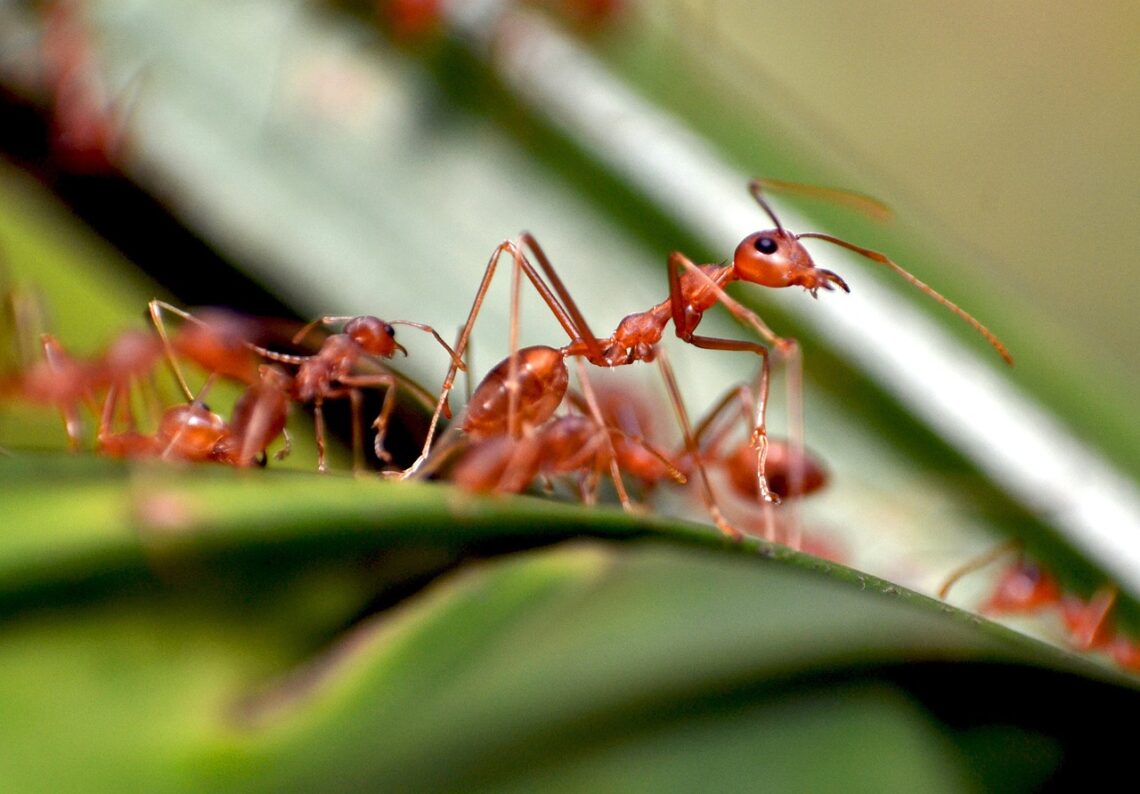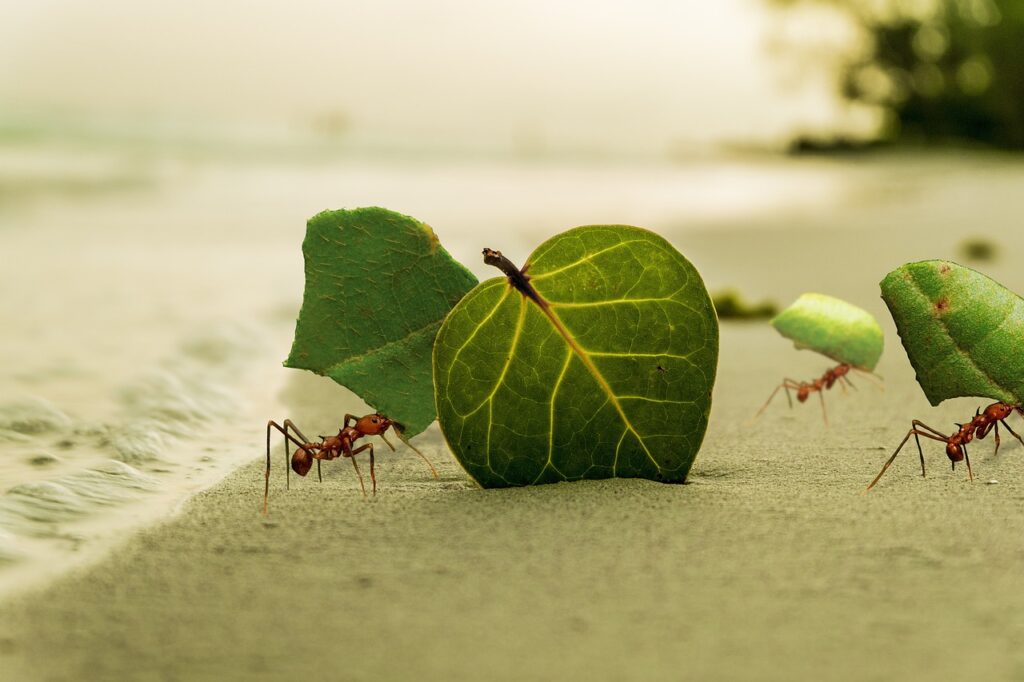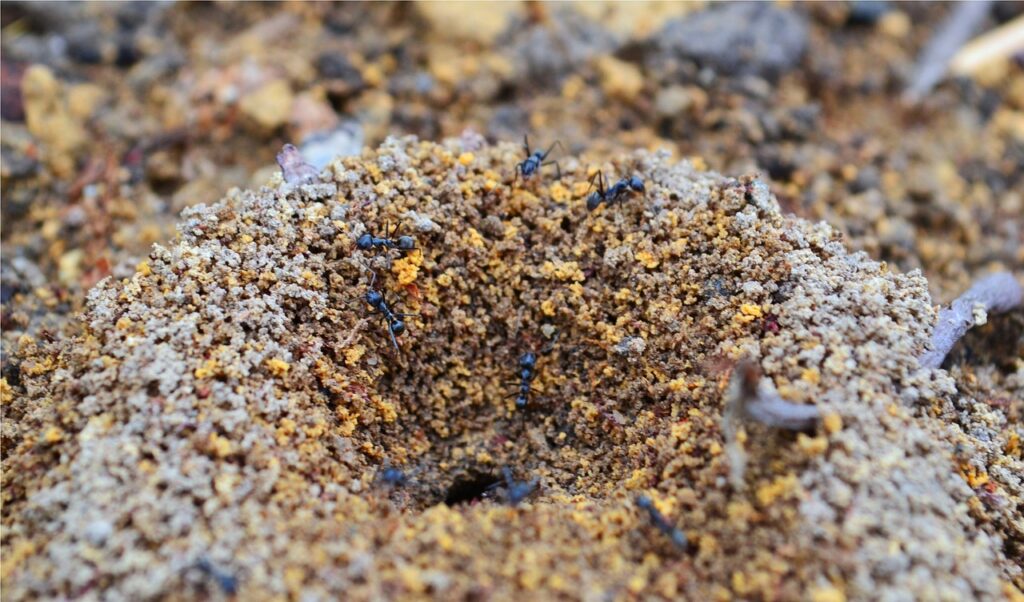
Fun And Fascinating Facts About Ants (The Best 60)
Facts About Ants
Ants, those tiny insects we often overlook, are some of the most remarkable creatures on our planet. In this article “Facts About Ants”, we’re delving deep into the world of ants to uncover incredible facts about their lives, behaviors, and habitats. Join us on this journey as we explore the fascinating universe of these social insects.
Ant Species: A Diverse World
Ants belong to a vast and diverse family of insects known as Formicidae. These small but mighty creatures can be found on every continent on Earth, with the exception of Antarctica. In fact, they’ve adapted to various environments and climates, making them one of the most widespread insect families globally.
Queen Ants: The Colony’s Matriarchs
Every ant colony has a queen, the heart and soul of the colony. Thus Queen ants are the reproductive powerhouses, laying thousands of eggs throughout their lives. Their primary role is to ensure the colony’s survival by producing worker ants and, occasionally, future queens.
Facts About Ants

Worker Ants: The Backbone of the Colony
Firstly, worker ants are the unsung heroes of the ant world. So these industrious individuals make up the majority of the colony and take care of tasks like foraging for food, building and repairing nests, and caring for the young. In fact they can carry objects up to 50 times their own body weight, showcasing their incredible strength.
Army Ants: Nature’s Swarm
Army ants, also known as soldier ants are found in tropical regions of South America, and are known for their massive colonies and aggressive hunting behavior. Indeed they go on relentless hunting marches, consuming everything in their path. These ants serve as an essential part of their ecosystem’s balance.
Bullet Ant: The Insect with a Painful Sting
The bullet ant earns its name due to its painful sting, which is considered one of the most painful insect stings on the planet. Native to South America, this ant’s sting is so intense that it’s compared to being shot by a bullet. It’s a fascinating example of nature’s defense mechanisms.
Argentine Ants: A Global Invasion
Argentine ants have established themselves as one of the most successful invasive ant species worldwide. So these tiny invaders form supercolonies that can stretch for miles. Also their ability to cooperate and outcompete native species has made them a significant concern for ecosystems.
Ant Communication: The Power of Chemical Signals
Ants communicate primarily through chemical signals, known as pheromones. These scent trails help ants navigate and find food sources efficiently. Furthermore they leave pheromone trails that lead other ants to the discovered food, creating a highly organized foraging system.
Leafcutter Ants: Fungus Farmers

Did you know that Leafcutter ants have a remarkable partnership with fungi? They don’t eat leaves directly but use them to cultivate fungus gardens in their nests. Also, these ants carefully tend to their fungal crops, and the fungus becomes a vital part of their diet.
Carpenter Ants: Nature’s Architects
Carpenter ants are known for their ability to carve intricate tunnels and chambers in wood. While they don’t eat the wood like termites, their nesting habits can cause structural damage to buildings. Also understanding their behavior is crucial for pest control.
Odorous House Ants: A Common Household Pest
Odorous house ants often invade homes, leaving a distinct, unpleasant odor when crushed. However these small, brown ants are a common nuisance, and understanding their habits can help homeowners deal with infestations effectively.
Facts About Ants, 5 Frequently Asked Questions

Do all ants have queens?
No, not all ants have queens. Ant colonies typically consist of a single queen, but some species may have multiple queens, while others may be entirely queenless. Also the presence or absence of queens depends on the species and their social structure.
How many worker ants are there in a typical colony?
The number of worker ants in a colony can vary widely depending on the species. Small colonies may have just a few dozen workers, while larger colonies can consist of thousands or even millions of workers.
What makes the bullet ant’s sting so painful?
The bullet ant’s sting is excruciating due to the potency of its venom. The venom contains a neurotoxin that causes intense pain, often described as feeling like a bullet wound, hence the name. The pain can last for hours and is considered one of the most painful insect stings in the world.
How do ants use pheromones to communicate?
Ants use pheromones, chemical substances, to communicate with one another. They leave pheromone trails on the ground, which other ants can follow to find food sources or navigate back to the nest. The intensity and composition of the pheromone signals convey information about the direction and importance of the task.
Are there any benefits to having ants in the garden?
Yes, there are benefits to having ants in the garden. Ants help control populations of other pests like aphids and caterpillars by preying on them or competing for resources. They also aid in seed dispersal, which can promote the growth of various plant species. However, some ant species may also disturb plant roots or create nests in inconvenient places, so their presence should be managed carefully.
Facts About Ants

Ant Nests: Engineering Marvels
Ants are true architects of the insect world. Indeed they construct elaborate nests that serve as their homes and hubs of activity. In fact the design and construction of these nests vary widely among different ant species.
Lasius Niger: The Black Garden Ant
Firstly the black garden ant, scientifically known as Lasius niger, is one of the most common ant species in Europe. Furthermore these ants create intricate underground nests in soil and decaying wood. Their colonies can house thousands of ants and are often found beneath stones or in lawns.
Social Insects: Teamwork at Its Best
Ants are social insects, meaning they live in colonies where cooperation is key to their survival. Also the division of labor among ants is remarkable, with different individuals specializing in various tasks. Additionally this teamwork is vital for their colony’s success.
The Colony Structure: A Complex Society
Ant colonies are structured societies with different castes. The queen is the reproductive female, while worker ants are responsible for foraging, caring for the young, and defending the colony. Some colonies also have male ants whose sole purpose is mating.
Pheromone Trails: Guiding the Way
Ants rely heavily on pheromone trails to communicate and navigate. In fact they secrete pheromones from specialized glands to leave a chemical trail on the ground. As a result, other ants follow these trails to locate food sources, find their way back to the nest, or communicate danger.

Ant Facts: Amazing and Bizarre
Here are some intriguing ant facts that showcase their incredible diversity and adaptability:
- The largest ant species in the world is the giant forest ant, found in Africa and Asia. Some individuals can reach up to 2 inches in length.
- Ants are the world’s strongest creatures relative to their size. They can carry objects hundreds of times their weight.
- The total number of ants on Earth is estimated to be in the quadrillions, surpassing the number of human beings.
- Ants have been around for a long time, with fossil evidence dating back to the mid-Cretaceous period, over 100 million years ago.
Facts About Ants
The Fascination with Ants
Ants have captured the interest of entomologists and nature enthusiasts for centuries. However, one renowned entomologist, Ted R. Schultz, has dedicated his career to studying ants. In fact, his research has shed light on their complex behaviors and evolutionary history.
Ant Colonies: Small Worlds within a World
Ant colonies can vary greatly in size. Some contain just a few dozen individuals, while others, like those of the Argentine ants, can stretch for miles. Also each colony functions as a self-contained ecosystem, with ants working together to meet their basic needs.
The Crucial Role of Ants in Ecosystems
Ants play a crucial role in their ecosystems. They help control populations of other insects by preying on them or competing for resources. Additionally, ants are important seed dispersers, aiding in the growth of various plant species.
Ants as Nature’s Cleanup Crew

Ants are like nature’s sanitation workers. They play a vital role in cleaning up their surroundings by scavenging dead insects and other organic matter. Their efforts contribute to nutrient recycling in ecosystems.
World’s Smartest Insects
Ants are renowned for their problem-solving abilities and adaptability. Their collective intelligence allows them to overcome obstacles and find innovative solutions to challenges.
Fire Ant Colonies: An Intriguing Social Structure
Fire ants are known for their aggressive behavior and painful stings. Their colonies consist of worker ants, a queen, and male ants. The queen is responsible for laying eggs, while the worker ants defend the nest and forage for food.
Slave-Making Ants: Cunning and Complex
Some ant species are known as slave-making ants. They raid the nests of other ant species, steal their pupae, and raise them as workers in their own colonies. This behavior is a remarkable example of parasitic behavior in the ant world.
The Most Painful Sting: The Bullet Ant
The bullet ant’s sting is so excruciating that it has earned a reputation as the most painful insect sting in the world. Indigenous tribes in South America use it as a rite of passage for young boys, who must endure the pain to become men.
Facts About Ants

Visual Cues and Trap-Jaw Ants
Ants also rely on visual cues to navigate and communicate. Some ant species, like trap-jaw ants, are known for their lightning-fast jaws, which they use for hunting and defense.
L. Niger Queens: Founders of the Colony
The reproductive success of an ant colony hinges on the queen. The queen ant is the founder and mother of the entire colony. She can live for several years, laying thousands of eggs during her lifetime.
From Tiny Holes to Whole Colonies
Ants are known for their ability to infiltrate small spaces. They can enter homes through tiny cracks and crevices, often in search of food. It’s essential to understand their behavior to prevent infestations.
The Humble Ant: A Remarkable Survivor
Despite their small size, ants have thrived on Earth for millions of years. Their adaptability, teamwork, and remarkable behaviors make them some of the most fascinating creatures in the animal kingdom.
Facts About Ants: A Diverse Array of Species
Ants are not a monolithic group; they comprise a diverse array of species, each with its unique characteristics and behaviors.
Different Species, Different Traits
Ant species exhibit remarkable diversity. Some are aggressive hunters, while others are gentle herbivores. Let’s explore some of the most intriguing ant species and their distinct traits:
Flying Ants: A Phenomenal Transformation

Many people are familiar with the sight of flying ants swarming in the air. These are typically reproductive ants, both males and females, on a mission to find a mate and start new colonies. This phenomenon is known as the nuptial flight.
Europe’s Most Common Ant: Lasius Niger
The Lasius niger, or black garden ant, is prevalent in Europe. These ants are small and dark in color, typically found foraging for food in gardens and yards. Understanding their habits can help manage ant problems in the home.
Different Types of Ants: A World of Variety
The world of ants is teeming with diversity. Here are some examples of the different types of ants and their unique characteristics:
- Weaver Ants: These ants are skilled builders, weaving intricate nests using leaves and silk produced by their larvae.
- Leafcutter Ants: As mentioned earlier, they cultivate fungus for food. They are also known for their distinctive leaf-cutting behavior.
- Trap-Jaw Ants: These ants have incredibly fast jaws that they use to snap shut on prey or as a means of escape from predators.
- Argentine Ants: Known for forming enormous supercolonies, Argentine ants are a global invasive species.
Facts About Ants: A Remarkable Blend of Biology and Behavior
Ants exhibit a fascinating blend of biology and behavior that has allowed them to thrive across the globe.
The Ant Queen’s Fate
The fate of a female ant is largely determined by her role within the colony. Most female ants serve as workers and caretakers, supporting the queen in her reproductive role. Only a few are destined to become future queens.
Unfertilized Eggs: The Birth of Male Ants
Male ants are produced from unfertilized eggs laid by the queen. Their sole purpose is to mate with virgin queens during the nuptial flight. Once they have fulfilled this role, their lives come to an end.
The Entire Life of a Single Ant
The life of an individual ant can vary significantly depending on its caste. Worker ants, for instance, have relatively short lifespans, typically living for a few weeks to a few months. Queen ants, on the other hand, can live for several years.
Facts About Ants

Ants Alive Today: A Glimpse into Evolution
Ants, with their diverse forms and behaviors, offer a unique glimpse into the process of evolution. Through countless generations, ants have adapted to a wide range of ecological niches, leading to the incredible diversity we see today.
The Ant Populations: Beyond Counting
Estimating the global ant population is a monumental task due to their sheer numbers. With thousands of species and trillions of individual ants, they play a significant role in ecosystems worldwide.
Facts About Ants: Masters of Survival
Ants have evolved and mastered survival strategies that have allowed them to endure for millions of years.
Tiny Holes, Massive Colonies
Ants are known for their ability to enter homes and structures through minuscule openings. Understanding their behavior is crucial for effective pest control.
Tiny Insects, Big Impact
Despite their small size, ants have a substantial impact on ecosystems. They help control pest populations, disperse seeds, and contribute to nutrient cycling.
Linepithema Humile: An Invasive Force
The Argentine ant, Linepithema humile, has established supercolonies in many parts of the world, outcompeting native ant species. Indeed their adaptability and rapid reproduction make them formidable invaders.
The Ant Queen: The Heart of the Colony
The queen ant is the heart of the colony, ensuring its continuity through her prolific egg-laying. Her role is central to the success of the entire ant society.
Facts About Ants

World’s Strongest Creatures: A Mighty Feat
Ants are among the world’s strongest creatures relative to their size. Their remarkable strength allows them to perform incredible feats, such as lifting objects many times their weight.
A World of Ants: From Tiny Holes to the Human Imagination
Ants have captivated human imagination and curiosity for centuries. From their diverse species to their intricate behaviors, ants are a testament to the wonders of the natural world.
Surprising Facts About Ants: Ants in the Human World
Ants have left their mark on human culture in various ways. In fact they appear in folklore, literature, and even as symbols of industry and cooperation. The world of ants continues to surprise and inspire us.
Facts About Ants Conclusion
In conclusion, ants are more than just tiny insects that scurry around our homes and gardens. They are a testament to the marvels of evolution, adaptation, and cooperation in the natural world. From their diverse species to their remarkable behaviors, ants are a source of fascination and wonder. So, the next time you encounter these small but mighty creatures, take a moment to appreciate the intricate world of ants that exists right under our feet. Now read my Best 20 Interesting Facts About Snapping Turtles.





2 Comments
Pingback:
Pingback: